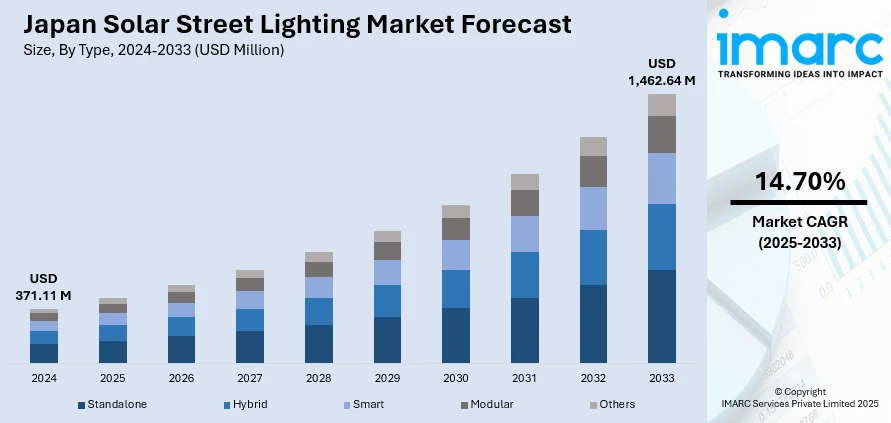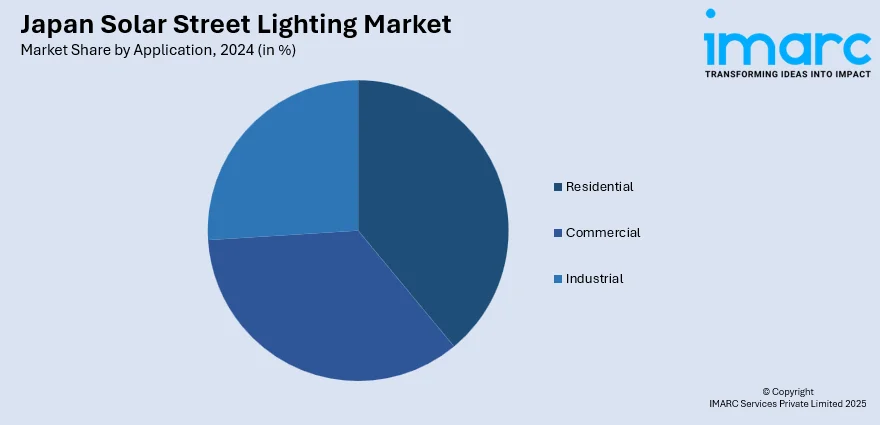
Japan Solar Street Lighting Market Size, Share, Trends and Forecast by Type, Application, and Region, 2025-2033
Japan Solar Street Lighting Market Overview:
The Japan solar street lighting market size reached USD 371.11 Million in 2024. Looking forward, IMARC Group expects the market to reach USD 1,462.64 Million by 2033, exhibiting a growth rate (CAGR) of 14.70% during 2025-2033. At present, with Japan placing a strong emphasis on the employment of renewable energy, the use of solar street lighting is increasing, providing reliable illumination for urban and rural regions. Besides this, rising tourism activities are contributing to the expansion of the Japan solar street lighting market share.
|
Report Attribute
|
Key Statistics
|
|---|---|
|
Base Year
|
2024 |
|
Forecast Years
|
2025-2033
|
|
Historical Years
|
2019-2024
|
| Market Size in 2024 | USD 371.11 Million |
| Market Forecast in 2033 | USD 1,462.64 Million |
| Market Growth Rate 2025-2033 | 14.70% |
Japan Solar Street Lighting Market Trends:
Increasing adoption of renewable energy
The rising adoption of renewable energy is positively influencing the market. As per industry reports, in 2024, Japan's biggest contributor to low-carbon electricity was solar power, whose proportion increased five times since 2014 to make up 10% of total generation. Japan ranked as the fourth largest solar power producer across the globe. The ongoing employment of renewable energy is part of Japan’s broader environmental goals to decrease greenhouse gas emissions. Solar street lighting, which uses solar panels to power light emitting diode (LED) lights, provides an efficient and eco-friendly alternative to traditional grid-powered streetlights. As Japan is experiencing rising energy costs and environmental concerns, there is a growing shift towards utilizing solar energy to power public infrastructure. Solar street lights are becoming particularly attractive because they aid in minimizing dependence on electricity from fossil fuels, lowering carbon footprints and energy usage. Additionally, the Government’s emphasis on renewable energy and smart city initiatives is supporting the expansion of solar-powered street lighting systems. The rising need for sustainable and low-maintenance lighting solutions that can be installed in remote areas with unreliable grid access is further strengthening the market growth.

Growing tourism activities
Rising tourism activities are impelling the Japan solar street lighting market growth. According to the Japan National Tourism Organization, Japan welcomed a historic 36.9 Million international tourists in 2024, reflecting a 47.1% increase compared to 2023. As more tourists are visiting Japan’s cities, cultural landmarks, and natural attractions, there is a greater need to improve public infrastructure, including outdoor lighting. Solar street lights are an ideal solution for enhancing the safety and visibility of popular tourist spots, parks, and coastal areas, while also maintaining environmental sustainability. These lights are easy to install and require minimal maintenance, which is essential in high-traffic tourist destinations. Additionally, the Government’s efforts to make Japan more eco-conscious are attracting tourists who value environmental responsibility.
Rising infrastructure development
Increasing infrastructure development is offering a favorable market outlook. As Japan continues to expand and modernize its cities, there is a growing need for reliable and eco-friendly street lighting in new residential areas, commercial districts, and public spaces. Solar street lights are ideal for such developments, as they are easy to install, require no connection to the electrical grid, and can be placed in locations with limited access to power lines. Additionally, these lights align with Japan’s sustainability goals, helping to reduce energy utilization and carbon emissions in urban centers. As construction projects are expanding, the need for smart, low-maintenance, and renewable energy solutions like solar street lighting is rising, making it a key driver in the market. As per industry reports, the Japanese construction sector is projected to grow by 1.7% in real terms in 2024.
Japan Solar Street Lighting Market Segmentation:
IMARC Group provides an analysis of the key trends in each segment of the market, along with forecasts at the country and regional levels for 2025-2033. Our report has categorized the market based on type and application.
Type Insights:
- Standalone
- Hybrid
- Smart
- Modular
- Others
The report has provided a detailed breakup and analysis of the market based on the type. This includes standalone, hybrid, smart, modular, and others.
Application Insights:

- Residential
- Commercial
- Industrial
A detailed breakup and analysis of the market based on the application have also been provided in the report. This includes residential, commercial, and industrial.
Regional Insights:
- Kanto Region
- Kansai/Kinki Region
- Central/ Chubu Region
- Kyushu-Okinawa Region
- Tohoku Region
- Chugoku Region
- Hokkaido Region
- Shikoku Region
The report has also provided a comprehensive analysis of all the major regional markets, which include Kanto Region, Kansai/Kinki Region, Central/Chubu Region, Kyushu-Okinawa Region, Tohoku Region, Chugoku Region, Hokkaido Region, and Shikoku Region.
Competitive Landscape:
The market research report has also provided a comprehensive analysis of the competitive landscape. Competitive analysis such as market structure, key player positioning, top winning strategies, competitive dashboard, and company evaluation quadrant has been covered in the report. Also, detailed profiles of all major companies have been provided.
Japan Solar Street Lighting Market Report Coverage:
| Report Features | Details |
|---|---|
| Base Year of the Analysis | 2024 |
| Historical Period | 2019-2024 |
| Forecast Period | 2025-2033 |
| Units | Million USD |
| Scope of the Report |
Exploration of Historical Trends and Market Outlook, Industry Catalysts and Challenges, Segment-Wise Historical and Future Market Assessment:
|
| Types Covered | Standalone, Hybrid, Smart, Modular, Others |
| Applications Covered | Residential, Commercial, Industrial |
| Regions Covered | Kanto Region, Kansai/Kinki Region, Central/Chubu Region, Kyushu-Okinawa Region, Tohoku Region, Chugoku Region, Hokkaido Region, Shikoku Region |
| Customization Scope | 10% Free Customization |
| Post-Sale Analyst Support | 10-12 Weeks |
| Delivery Format | PDF and Excel through Email (We can also provide the editable version of the report in PPT/Word format on special request) |
Key Questions Answered in This Report:
- How has the Japan solar street lighting market performed so far and how will it perform in the coming years?
- What is the breakup of the Japan solar street lighting market on the basis of type?
- What is the breakup of the Japan solar street lighting market on the basis of application?
- What is the breakup of the Japan solar street lighting market on the basis of region?
- What are the various stages in the value chain of the Japan solar street lighting market?
- What are the key driving factors and challenges in the Japan solar street lighting market?
- What is the structure of the Japan solar street lighting market and who are the key players?
- What is the degree of competition in the Japan solar street lighting market?
Key Benefits for Stakeholders:
- IMARC’s industry report offers a comprehensive quantitative analysis of various market segments, historical and current market trends, market forecasts, and dynamics of the Japan solar street lighting market from 2019-2033.
- The research report provides the latest information on the market drivers, challenges, and opportunities in the Japan solar street lighting market.
- Porter's five forces analysis assist stakeholders in assessing the impact of new entrants, competitive rivalry, supplier power, buyer power, and the threat of substitution. It helps stakeholders to analyze the level of competition within the Japan solar street lighting industry and its attractiveness.
- Competitive landscape allows stakeholders to understand their competitive environment and provides an insight into the current positions of key players in the market.
Need more help?
- Speak to our experienced analysts for insights on the current market scenarios.
- Include additional segments and countries to customize the report as per your requirement.
- Gain an unparalleled competitive advantage in your domain by understanding how to utilize the report and positively impacting your operations and revenue.
- For further assistance, please connect with our analysts.
 Request Customization
Request Customization
 Speak to an Analyst
Speak to an Analyst
 Request Brochure
Request Brochure
 Inquire Before Buying
Inquire Before Buying




.webp)




.webp)












